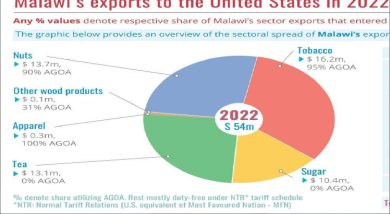Battered kwacha in marginal stability

After crashing against major trading currencies in 2013, the kwacha has stabilised in the last four weeks, thanks to Reserve Bank of Malawi (RBM) tight monetary policy.
According to RBM official exchange rates, the kwacha firmed against the dollar and the euro while the local unit marginally lost ground to the pound sterling by about 1.8 percent between December 24 and January 24.
The local unit appreciated against the rand by 5.8 percent during the same period.
But in 2013, the kwacha retreated against all major trading currencies prompting inflation to miss its target. Inflation rose to 22.9 percent in November 2013 while the annual average is projected to hit 28.6 percent from 21.4 percent in 2012.
The RBM late last year said it will further tighten the monetary policy to address challenges through the use of open market operations, bank rate and foreign exchange operations.
Last year, according to available statistics, the kwacha lost 29.9 percent against the dollar, crashed by 32.5 percent against the pound sterling and slipped by 5.7 percent against the rand. It also shed off 35.6 percent against the euro.
The RBM in its 2013 Economic and Financial Report for the third quarter noted that the local unit depreciated against major foreign currencies at the end of the third quarter due to lower donor inflows and a seasonal drop in tobacco proceeds during the period.
But in November last year in the wake of the aid freeze, the RBM in a policy statement said it was going to further tighten the monetary policy through exchange rate adjustment to ensure continued improvements in the availability of foreign exchange in the market while at the same time dampening inflationary pressures.
The central bank noted that the sharp fluctuations in the exchange rate that the country has experienced to-date, while not unique to Malawi, have largely been due to insufficient foreign reserves. The RBM therefore resolved to maintain an import cover of at least two months.
RBM spokesperson Mbane Ngwira earlier said the central bank has been targeting two months import cover as a rule of thumb, a measure which he described as credible.
Effective January 1, the RBM introduced the Lombard facility with a rate at two percentage points above the bank rate currently at 25 percent. The RBM argued that the facility would assist banks to manage their liquidity and ensure that they have access to funds.
Since December last year, the RBM has also engaged in open market operations issuing repurchase agreements (Repos), consequently yielding net withdrawals from the market to control money supply and rein in inflation.






There is good news and bad news for the monetary policy in Malawi as I see it. The good news is that with the introduction of the marginal lending facility (Lombard rate), RBM seems to have completed putting in place all requisite monetary instruments 1). Open market operations – 3 monthly repos e.g. at 40%, (14 day repo are a must have to even supersede 3 monthly repos eventually), 2). Automatic facilities (deposit facilities and Lombard rate 27.5%, 3). Minimum reserves requirements 15.5%, 4).FX interventions. Monitoring of real exchange rates (REER) is on-going. The kwacha depreciating has just a little longer to go before it will turn the corner and start going up once again. With a floated currency, 3 months import cover is no longer necessary and lastly Malawi will nonetheless accumulate more reserves this coming year during tobacco sales to build on last years gains.
The bad news is that all the current settings of these instruments are too high. Inflation at 23% is too high; it should be targeted at 2% plus or minus 1%. Not only does this hit people’s pockets per se, it also contributes to the depreciation of the kwacha and makes the economy uncompetitive. In order to stimulate investment, RBM must lower interest rates parameter settings and in particular focus on managing a narrow corridor of interest rates. After all, monetary policy is about steering the short end of the yield curve. Other countries may not reveal their settings for competitive edge reasons but here are typical values that most central banks now achieve: Bank rate 0.05%, Lombard rate 0.25%, interbank (deposits bid 0.03%/borrow 0.17%), and LRR 2%. In order to manage this low liquidity reserve requirement, they have introduced a collateralised intra-day credit facility for commercial banks to use if need be. So there, you can copy paste…(LOL). It is not important just to make investment capital available to small businesses but at low lending rates so they have better chance of surviving the critical first 2 years! Low rates will also enable a greater proportion of Malawians to invest in the up coming large scale investment opportunities in mines, oils, revolution industries etc. Above all low rates will create an economic boom in the country to improve the standard of living in addition to stopping the kwacha from further depreciating.
Just a point of interest to RBM, Why is IMF including petroleum products (petrol, diesel and paraffin) in calculating the commodity terms of trade (CTOT) for Malawi? Malawi may have petroleum oil underground ground but oil is not yet part of Malawi export commodity basket (or is it already?) Why was it included in 2012 IMF review report no. 13/119 page 62? “The commodities are: Tobacco, Uranium, Tea, Sugar, Cotton, Rice, Coffee, Maize, Petroleum Products, and Fertilizers”. Fertiliser is not manufactured in Malawi neither (or is it?) Maybe they are produced in Malawi in which case that is OK; but if not then they should not have been included otherwise these commodities severely distorted the equilibrium real exchange rate determination; to the disadvantage of the Kwacha valuation. Recalculate CTOT without oil and see how dramatic the results get especially using the 2014 manufacturing unit value – MUV(15) – for those in the know.
I have an ulterior motive that everyone must know (lol). I want all the above macroeconomic fundamentals to be in place beforehand ready for an “industrial revolution” that I want to instigate in Malawi by working with the government of the day and all Malawians. The above discussed issues do not transform an economy by themselves but they create a conducive environment for investment, job creation, economic growth and price stability. It is time Malawi approached the challenge of development differently with renewed vigour, decisiveness, unity of purpose and self belief based on scientific approach not trial and error. Those in the diaspora who want to be part of this, your talent and expertise in all your chosen fields will be highly needed back in Malawi. Malawi does not need to waste another decade in doldrums!